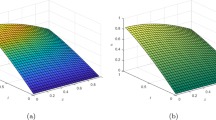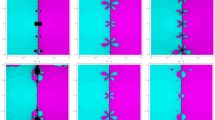Abstract
Based on the concept of improving the convergence of Fourier series by elimination of the Gibbs phenomenon, this work proposes a rational approach to construct hierarchic sets of shape functions of any desired degree of continuity from suitably modified (enriched) trigonometric series. Hierarchic sets of either enriched cosines or enriched sines are then used in Ritz solutions of beam and plate bending problems to illustrate the benefits provided by the enrichment in the quality of approximations. For a given degree of continuity, it is observed that a set of enriched cosines yields, in general, more accurate results and faster convergence than a set of enriched sines. To the authors’ knowledge, there is no published information yet on hierarchic sets of enriched cosines. Moreover, it is shown that some hierarchic sets, which are already well-established in the literature, may lead not only to spurious oscillations but also to erroneous results.









Similar content being viewed by others
References
Lanczos, C.: Discourse on Fourier Series. Oliver and Boyd, Edinburgh (1966)
Jones, W.B., Hardy, G.: Accelerating convergence of trigonometric approximations. Math. Comp. 24(111), 547–560 (1970)
Baszenski, G., Delvos, F.J., Tasche, M.: A united approach to accelerating trigonometric expansions. Comput. Math. Applic. 30(3–6), 33–49 (1995). https://doi.org/10.1016/0898-1221(95)00084-4
Li, W.L.: Reply to: Discussion on “Free vibrations of beams with general boundary conditions.” J. Sound Vib. 257(3), 593–595 (2002). https://doi.org/10.1006/jsvi.2002.5195
Iguchi, S.: Allgemeine lösung der knickungsaufgabe für rechteckige platten. Ing.-Arch. 7(4), 207–215 (1936). https://doi.org/10.1007/BF02095891
Iguchi, S.: Die biegungsschwingungen der vierseitig eigenspannten rechteckigen platte. Ing.-Arch. 8(1), 11–25 (1937). https://doi.org/10.1007/BF02086517
Iguchi, S.: Die knickung der rechteckigen platte durch schubkräfte. Ing.-Arch. 9(1), 1–12 (1938). https://doi.org/10.1007/BF02084324
Leggett, D.M.A.: The buckling of a square panel under shear when one pair of opposite edges is clamped, and the other pair is simply supported, Tech. Rep. 1991, Aeronautical Research Committee, London, (1941)
Li, W.L.: Free vibrations of beams with general boundary conditions. J. Sound Vib. 237(4), 709–725 (2000). https://doi.org/10.1006/jsvi.2000.3150
Li, W.L.: Dynamic analysis of beams with arbitrary elastic supports at both ends. J. Sound Vib. 246(4), 751–756 (2001). https://doi.org/10.1006/jsvi.2001.3603
Li, W.L.: Comparison of Fourier sine and cosine series expansions for beams with arbitrary boundary conditions. J. Sound Vib. 255(1), 185–194 (2002). https://doi.org/10.1006/jsvi.2001.4108
Li, W.L.: Vibration analysis of rectangular plates with general elastic boundary supports. J. Sound Vib. 273(3), 619–635 (2004). https://doi.org/10.1016/S0022-460X(03)00562-5
Li, W.L.: Alternative Fourier series expansions with accelerated convergence. Appl. Math. 7(15), 1824–1845 (2016). https://doi.org/10.4236/am.2016.715152
Xu, H., Li, W.L., Du, J.: Modal analysis of general plate structures. J. Vib. Acoust. 136(2), 021002 (2014). https://doi.org/10.1115/1.4025876
Jin, G., Ye, T., Su, Z.: Structural Vibration—A Uniform Accurate Solution for Laminated Beams. Plates and Shells with General Boundary Conditions. Springer, Heidelberg (2015)
Yshii, L.N., Lucena Neto, E., Monteiro, F.A.C., Santana, R.C.: Accuracy of the buckling predictions of anisotropic plates. J. Eng. Mech. 144(8), 04018061 (2018). https://doi.org/10.1061/(ASCE)EM.1943-7889.0001498
Beslin, O., Nicolas, J.: A hierarchical functions set for predicting very high order plate bending modes with any boundary conditions. J. Sound Vib. 202(5), 633–655 (1997). https://doi.org/10.1006/jsvi.1996.0797
West, L.J., Bardell, N.S., Dunsdon, J.M., Loasby, P.M.: Some limitations associated with the use of K-orthogonal polynomials in hierarchical versions of the finite element method, In Proceedings of the Sixth International Conference on Recent Advances in Structural Dynamics, vol. 1, pp. 217–231 (1997)
Bardell, N.S., Dunsdon, J.M., Langley, R.S.: Free vibration analysis of coplanar sandwich panels. Compos. Struct. 38(1–4), 463–475 (1997). https://doi.org/10.1016/S0263-8223(97)00080-9
Bardell, N.S., Dunsdon, J.M., Langley, R.S.: Free vibration of thin, isotropic, open, conical panels. J. Sound Vib. 217(2), 297–320 (1998). https://doi.org/10.1006/jsvi.1998.1761
Leung, A.Y.T., Chan, J.K.W.: Fourier p-element for the analysis of beams and plates. J. Sound Vib. 212(1), 179–185 (1998). https://doi.org/10.1006/jsvi.1997.1423
Houmat, A.: An alternative hierarchical finite element formulation applied to plate vibrations. J. Sound Vib. 206(2), 201–215 (1997). https://doi.org/10.1006/jsvi.1997.1076
Houmat, A.: A sector Fourier p-element applied to free vibration analysis of sectorial plates. J. Sound Vib. 243(2), 269–282 (2001). https://doi.org/10.1006/jsvi.2000.3410
Haberman, R.: Applied Partial Differential Equations with Fourier Series and Boundary Value Problems, 5th edn. Pearson, Boston (2013)
Tolstov, G.P.: Fourier Series. Dover, New York (1976)
Dozio, L.: Free in-plane vibration analysis of rectangular plates with arbitrary elastic boundaries. Mech. Res. Commun. 37(7), 627–635 (2010). https://doi.org/10.1016/j.mechrescom.2010.09.003
Dozio, L.: On the use of the Trigonometric Ritz method for general vibration analysis of rectangular Kirchhoff plates. Thin-Walled Struct. 49(1), 129–144 (2011). https://doi.org/10.1016/j.tws.2010.08.014
Dozio, L.: In-plane free vibrations of single-layer and symmetrically laminated rectangular composite plates. Compos. Struct. 93(7), 1787–1800 (2011). https://doi.org/10.1016/j.compstruct.2011.01.021
Dang, T.D., Kapania, R.K., Patil, M.J.: Ritz analysis of discontinuous beams using local trigonometric functions. Comput. Mech. 47(3), 235–250 (2011). https://doi.org/10.1007/s00466-010-0540-y
Paik, J.K.: Ultimate Limit State Analysis and Design of Plated Structures, 2nd edn. John Wiley, Hoboken (2018)
Mousavi, H., Azhari, M., Saadatpour, M.M.: A novel formulation for static and buckling analysis of plates using coupled element free Galerkin-finite strip (EFG-FS). Appl. Math. Model. 70, 264–284 (2019). https://doi.org/10.1016/j.apm.2019.01.019
Yeh, S.L., Harne, R.L.: Origins of broadband vibration attenuation empowered by optimized viscoelastic metamaterial inclusions. J. Sound Vib. 458, 218–237 (2019). https://doi.org/10.1016/j.jsv.2019.06.018
Chen, Q., Qiao, P.: Buckling and postbuckling of rotationally-restrained laminated composite plates under shear. Thin-Walled Struct. 161, 107435 (2021). https://doi.org/10.1016/j.tws.2021.107435
Mousavi, H., Azhari, M., Saadatpour, M.M., Sarrami-Foroushani, S.: Application of improved element-free Galerkin combining with finite strip method for buckling analysis of channel-section beams with openings. Eng. Comput. 38(1), 739–755 (2022). https://doi.org/10.1007/s00366-020-01087-8
Reddy, J.N.: Energy Principles and Variational Methods in Applied Mechanics, 2nd edn. John Wiley, Hoboken (2002)
Lucena Neto, E.: Fundamentals of Structural Mechanics (in Portuguese). Orsa Maggiore, Florianópolis (2021)
Courant, R., Hilbert, D.: Methods of Mathematical Physics, vol. 1. John Wiley, New York (1953)
Oliveira, B.H.S., Lucena Neto, E., Monteiro, F.A.C.: An accurate Ritz approach for analysis of cracked stiffened plates. Appl. Math. Model. 73, 598–614 (2019). https://doi.org/10.1016/j.apm.2019.04.014
Author information
Authors and Affiliations
Corresponding author
Ethics declarations
Conflict of interest
The authors declare that they have no conflict of interest.
Additional information
Publisher's Note
Springer Nature remains neutral with regard to jurisdictional claims in published maps and institutional affiliations.
Appendices
Appendix A
For \(C^{0}\) continuity, the components of the set \({\mathbf{F}}_{c}\) of enriched cosines read
with properties
For numerical convenience, one replaces \(x\) by the nondimensional coordinate \(\xi = 2x/L - 1\) (\(- 1 \le \xi \le 1\)). The first two functions of \({\mathbf{F}}_{c}\) are the nodal components collected in \({\varvec{\psi}}\), whereas the remaining ones are the hierarchic components collected in \({\mathbf{H}}\). The components of the set \({\mathbf{F}}_{s}\) of enriched sines are
with the same properties (A.2).
Similarly, the components of \({\mathbf{F}}_{c}\) for \(C^{1}\) continuity are given by
with properties
The components of \({\mathbf{F}}_{s}\) are
with the same properties (A.5).
For \(C^{2}\) continuity, the components of \({\mathbf{F}}_{c}\) change to
with properties
In turn, the components of \({\mathbf{F}}_{s}\) are given by
with the same properties (A.8).
The sets (A.3), (A.6) and (A.9) are also developed in [21, 23] and [22], respectively, but without worrying about convergence aspects of the sine series expansion. The hierarchic functions \(F_{sj}\) (\(j = 5, 6, \ldots\)) of the set (A.6) were first proposed by Iguchi [6].
Appendix B
2.1 Beam bending
It is convenient to rewrite the potential energy (48) as follows
where a comma followed by \(\xi\) indicates differentiation with respect to \(\xi\). Substitution of the approximation \(v\left( \xi \right) \approx {\mathbf{H}}^{T} {\mathbf{h}}\) into (B.1) yields
with
The discrete form of the equations that govern the response of the beam bending is given by the stationary condition of \({\Pi }\) with respect to \({\mathbf{h}}\):
2.2 Plate bending
In the nondimensional coordinates \(\xi = 2x/a - 1\) and \(\eta = 2y/b - 1\), the potential energy (52) reads
Substitution of the approximation (55), now written as \(w\left( {\xi ,\eta } \right) \approx {\mathbf{R}}^{{\text{T}}} {\mathbf{c}}\) in which \({\mathbf{R}}\) and \({\mathbf{c}}\) collect the Ritz basis functions and the unknown coefficients, into (B.5) gives
with
The discrete form of the equations that govern the response of the plate bending is
The Ritz basis can be expressed by means of the Kronecker product [38] as
retaining \(M\) and \(N\) shape functions in the sets \({\mathbf{X}}\) and \({\mathbf{Y}}\), respectively.
Rights and permissions
Springer Nature or its licensor (e.g. a society or other partner) holds exclusive rights to this article under a publishing agreement with the author(s) or other rightsholder(s); author self-archiving of the accepted manuscript version of this article is solely governed by the terms of such publishing agreement and applicable law.
About this article
Cite this article
Monteiro, F.A.C., Lucena Neto, E. Hierarchic sets of shape functions constructed from enriched Fourier series. Acta Mech 235, 671–690 (2024). https://doi.org/10.1007/s00707-023-03767-0
Received:
Revised:
Accepted:
Published:
Issue Date:
DOI: https://doi.org/10.1007/s00707-023-03767-0




